Fixed Point Arithmetic With Scaled Integers
Fixed Point Arithmetic With Scaled Integers
Fixed Point Arithmetic With Scaled Integers
You also want an ePaper? Increase the reach of your titles
YUMPU automatically turns print PDFs into web optimized ePapers that Google loves.
<strong>Fixed</strong> <strong>Point</strong> <strong>Arithmetic</strong> <strong>With</strong><strong>Scaled</strong> <strong>Integers</strong>CS 330August 23, 2010
<strong>Fixed</strong> <strong>Point</strong> Numbers as <strong>Scaled</strong> <strong>Integers</strong>• We can a approximate a real number xby storing it as a (binary) integer scaledby 2 n where n is the number of bits representingthe fractional portion of thenumber.• Approximating π by storing ⌊π ×2 16 ⌋ as a32-bit integer. The binary point is fixedbetween bit 15 and 16 (Q16.16):32 bits0000000000000011.0010010001111111binary pointn = 16(review binary and hex number systems; 2’s complement)
Motivation• May not have access to FPU(e.g., embedded DSP).• Integer operations faster than FPU.• Consistent results between platforms.• Unique value of zero (using 2’s complement).• Common in embedded systems
Decimal and Binary Fractionsfrac decimal binary1/1 1 or 0.9999 . . . 1 or 0.1111 . . .1/2 0.5 0.11/3 0.3333 . . . 0.010101. . .1/4 0.25 0.011/5 0.2 0.00110011 . . .1/6 0.1666. . . 0.0010101 . . .1/7 0.142857142857 . . . 0.001001. . .1/8 0.25 0.0011/9 0.111 . . . 0.000111000111 . . .1/10 0.1 0.000110011...Note: x/n terminates in binary iff n = 2 i
1/10 in <strong>Fixed</strong> <strong>Point</strong>0.1 10 ≈ 0.0001100110011001 2= 0.F 999 16= 0.0999908447 10error ≈ 9.15 × 10 −60.1 × 10 = 0.1 × (2 3 + 2 1 )≈ 0.1100110011001000 +0.0011001100110010= 0.1111111111111010
Addition and Subtraction(x × 2 n ) + (y × 2 n ) = (x + y) × 2 n(x × 2 n ) − (y × 2 n ) = (x − y) × 2 n• We assume binary point at same spot.• Straight forward use of integer additionand subtraction.
π + e3.141586 + 2.718277 = 5.8598630000000000000011.0010010000111111+ 0000000000000010.10110111111000010000000000000101.11011100001000000003.243F 16+ 0002.B7E1 160005.DC20 16
Multiplying Two <strong>Fixed</strong>-<strong>Point</strong> Numbers(x × 2 n ) × (y × 2 n ) = (x × y) × 2 2n• Note that resulting scaling factor requirestwice as many bits for the fraction!• Will overflow when |x · y| ≥ 1.• For our 32-bit integers (n = 16) we capturethe result into a 64-bit number:(x × 216 ) × ( y × 2 16) = (x × y) × 2 32– Upper 32 bits contain whole portion;– Lower 32 bits contain fraction.
π × e3.141586 * 2.718277 = 8.539701*0003.243F 160002.B7E1 1600000008.8A29E45F 16upper 32-bitswhole partrescale to 32-bitsround to nearestlower 32-bitsfraction0008.8A29 160008.8A2A 16
Rescale after multiplication• A 32-bit machine will save the 64-bitresult into two 32-bit registers:movl $0x0003243F, %eax /* EAX
Division of two <strong>Fixed</strong>-<strong>Point</strong> Numbers• Naïve division(x × 2 n ) ÷ (y × 2 n ) = (x ÷ y) × 2 0We have zero bits of fraction left!• We first scale the dividend by 2 n(x × 22n ) ÷ (y × 2 n ) = (x ÷ y) × 2 n• For our 32-bit fixed-point numbers wescale the dividend by 2 16 and store it asa 64-bit number.(x × 232 ) ÷ ( y × 2 16) = (x ÷ y) × 2 16
π ÷ e3.141586 ÷ 2.718277 = 1.155727upper 32-bitswhole partlower 32-bitsfraction00000003.243F0000 16÷ 0002.B7E1 160001.27DD 16zerofill
Pre-scale dividend before division• For a machine with 32-bit registers westore the 64-bit dividend in two registersfor a 32-bit divide operation:movl $0x0003243F, %eax /* EAX
• Digits of precision for 16-bit fraction:2 16 = 10 dlog 2 16 = log 10 d16 log 2 = b log 10d = 16 log 2log 10≈ 4.816 decimal digits• ɛ = smallest positive integer we can storeɛ = 2 −16 ≈ 0.00001526 = 0.1526 × 10 −4• Minimum and Maximum8000.0000 16 = −2 15 = −32, 768 107FFF.FFFF 16 = 2 15 − ɛ ≈ 32, 767.9999847 10
<strong>Fixed</strong> <strong>Point</strong> Line Rasterization
drawLine(x 0 , y 0 , x 1 , y 1 )∆y = y 1 − y 0∆x = x 1 − x 0if |∆y| ≥ |∆x| (vertical)m = ∆x/∆yy start = round(y 0 )y end = round(y 1 )x = x 0for y = y start . . . y endsetpixel(round(x), y)x = x + melse . . . (horizontal)
drawLine(int x0, int y0, int x1, int y1)(fixed-point coordinates, n = 16)int dy = y1 - y0;int dx = x1 - x0;if (abs(dy) > abs(dx)) {int m = ((int64_t) dx > 16;int yend = (y1 + 0x08000) >> 16;int yinc = (dy < 0) ? -1 : +1;int x = x0 + 0x08000;for (; y != yend; y += yinc) {setpixel(x >> 16, y);x += m;}} else ...


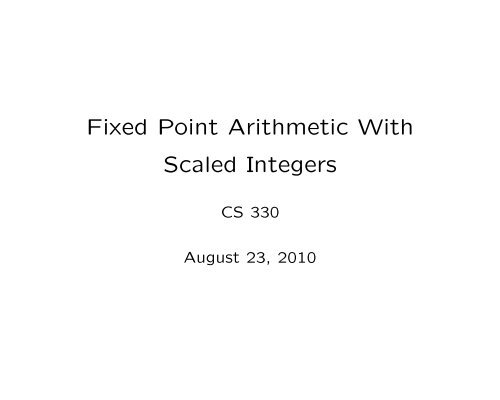
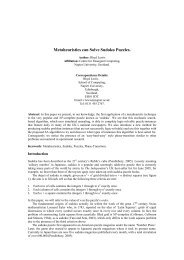
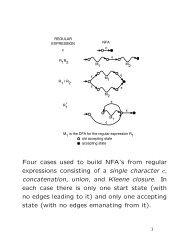
![[PDF] Fun with Syntax - ezekiel](https://img.yumpu.com/48148851/1/190x245/pdf-fun-with-syntax-ezekiel.jpg?quality=85)
![[PDF] Syntax and Semantics](https://img.yumpu.com/40036635/1/190x245/pdf-syntax-and-semantics.jpg?quality=85)

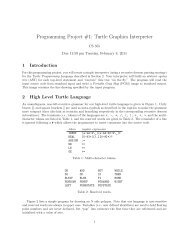
![[PDF] Turtle Graphics - ezekiel](https://img.yumpu.com/30626918/1/190x245/pdf-turtle-graphics-ezekiel.jpg?quality=85)
![[PDF] Intro to OpenGL and GLUT programming](https://img.yumpu.com/30459270/1/190x146/pdf-intro-to-opengl-and-glut-programming.jpg?quality=85)
![[PDF] CFL Pumping Lemma](https://img.yumpu.com/29995553/1/190x245/pdf-cfl-pumping-lemma.jpg?quality=85)

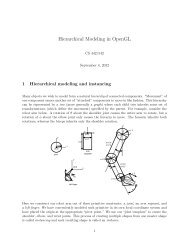
![[PDF] Encapsulation + Inheritance + Polymorphism](https://img.yumpu.com/24621947/1/190x245/pdf-encapsulation-inheritance-polymorphism.jpg?quality=85)